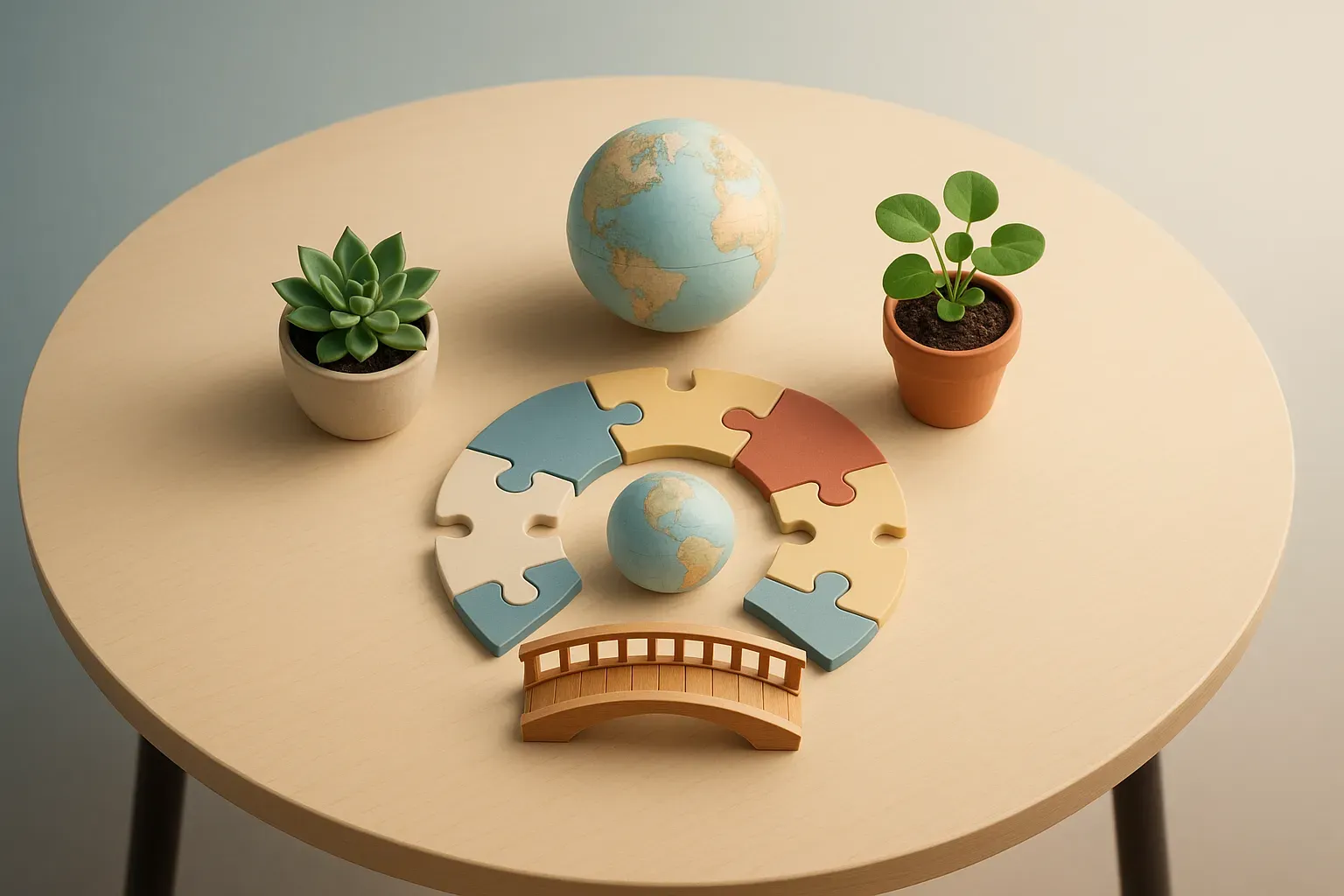Recent studies have shown that inclusive workplaces consistently outperform their competitors, with tangible benefits appearing across all business metrics. Industry experts share proven strategies and real-world examples of how diversity initiatives have transformed company cultures and sparked innovative thinking. These insights offer practical approaches for organizations seeking to build more equitable environments where all employees can thrive and contribute to business success.
- Memorial Jewelry Celebrates All Love Stories
- Structured Policies Ensure Equitable Work Environment
- Redefining Beauty Standards Through Inclusive Fashion
- Global Team Diversity Sparks Creative Innovation
- Diverse Voices Form Core Architecture
- Inclusive Practices Transform Company Culture
- Diverse Teams Deliver Better Business Results
- Prison Reform Experience Shapes Company Mission
Memorial Jewelry Celebrates All Love Stories
Incorporating diversity and inclusion into our company values began with acknowledging that memorial jewelry can mean something to anyone, regardless of their background, belief system, or family structure. Our team wanted our mission to be defined by the same inclusivity – we honor memories that speak through and in all types of love and loss. Everything from the way we depicted families in our visuals to the way we expressed ourselves on our website was adjusted to be caring, not directive.
For instance, one thing we did when expanding our product line was to co-create designs with artisans of different cultural backgrounds who brought in symbols and imagery that meant something to their and other people’s faiths and traditions. This expansion did not only grow our selection of products – it redefined our team’s idea of creativity and empathy in business. Our discussions as a team became more open; our marketing brainstorms became more complex. Our hiring process became more intentional.

Structured Policies Ensure Equitable Work Environment
Diversity and inclusion are woven into our hiring, talent development, and delivery of work approaches. We use a structured interviewing process applying the same criteria throughout the interviews, we share salary ranges for the roles, and we conduct regular pay equity reviews. We have an inclusivity checklist for our creative teams to review language, visual imagery, access, and cultural context when carrying out client work.
We make mentorship a priority to expand pathways to opportunity and have incorporated inclusivity into our PTO policy. We have employees from many different parts of the world, and to accommodate this diversity, each employee is allocated a generous number of days off. This ensures everyone is able to observe their religious and cultural holidays without concern. We train managers to use inclusive meeting norms and provide employee feedback to ensure all voices are captured. This creates greater trust, deeper candidate pipelines, stronger collaborative participation, as well as increased engagement and retention.

Redefining Beauty Standards Through Inclusive Fashion
I started Mermaid Way because I grew exhausted from seeing fashion only show one specific woman who had a particular skin color, body shape, and beauty standards. Our designs would honor all women by showcasing their natural features including their curves, scars, softness, and edges.
(2) That shift changed everything. Our team started using models who were from our community base including dancers, mothers, and healers. The models brought their unique presence to each piece because they moved in their own distinct way. Our entire creative process from photo shoots to fittings and social events now carries a distinct energy that reflects the new cultural atmosphere. Beauty evolved from a fixed standard into a wide range of possibilities.

Global Team Diversity Sparks Creative Innovation
We have embedded diversity into our mission by recognizing that learning is both universal and deeply personal. Our team reflects this belief through representation across the globe. Each member brings unique perspectives that challenge assumptions and encourage broader thinking. This diversity helps us grow as individuals and as a team, inspiring new ideas and innovative approaches.
We regularly celebrate cultural milestones and encourage team members to share their traditions. These moments of connection promote understanding beyond work and strengthen our relationships. They remind us that empathy and curiosity are at the heart of collaboration. The result is a workplace where creativity flourishes because everyone feels valued, heard, and included.

Diverse Voices Form Core Architecture
Absolutely. But to be blunt, diversity and inclusion were never “added” to my company’s values—they are the values. This isn’t a checkbox or a statement on a website. It’s the architecture.
I built my production company, Drop a Piano Productions, around the belief that stories matter most when they come from voices we’re not used to centering. Every script I’ve written—from Good to Mecca to Hi—puts race, queerness, gender, class, and moral ambiguity at the core. Not as themes. As truths.
Behind the scenes, that carries through. My collaborators—cast, crew, editors, assistants—reflect the world I actually live in. Not just because it looks good on a call sheet, but because it creates better work. When people feel safe, respected, and seen, they speak up. They bring ideas. They challenge the script in the right ways. And that’s when the story gets sharper.
The impact? We don’t have to fake “culture.” It’s there. People want to come to work. There’s trust in the room. There’s less ego. More ownership. More art.
And I’m not interested in going back to any other model.

Inclusive Practices Transform Company Culture
Here’s the best example of how I successfully incorporated diversity and inclusion into our company. I started by integrating inclusive hiring practices like blind recruitment and diverse interview panels to minimize bias. We created Employee Resource Groups that raised the voices of underrepresented employees and provided them with the needed support. This step boosted collaboration with a sense of belonging. The celebration of multicultural holidays and preference for inclusive language were a part of our company culture. That promoted respect and appreciation among various teams. Leadership accountability was set up using mentorship programs and diversity reporting, where talent from different cultures was encouraged.
The impact was significant, and our workplace became more innovative, where people from diverse backgrounds felt valued.

Diverse Teams Deliver Better Business Results
We made diversity and inclusion a core part of our hiring and team development practices from the ground up. Our recruitment process actively sources candidates from underrepresented groups in tech and marketing. Every job posting goes through a review to remove biased language. Our interview panels always include diverse team members. We also created mentorship programs that pair junior team members from underrepresented backgrounds with senior leaders. This gives everyone access to career growth opportunities. We track our diversity metrics quarterly and hold leadership accountable for progress.
The impact on our workplace culture has been significant. Our teams generate more creative solutions because people bring different perspectives to problems. Employee retention improved by 34% after we formalized these practices. Team members report feeling more valued and heard. We see this in our internal surveys and daily interactions. Our client work also improved because our diverse team better understands varied audiences. Different viewpoints help us create content strategies that resonate across demographics. Innovation increased as people felt safe sharing unconventional ideas. The business results speak for themselves—our client satisfaction scores rose alongside our internal culture improvements.

Prison Reform Experience Shapes Company Mission
Diversity and inclusion became the driving force of our mission after some years of working directly with individuals transitioning from the federal prison system. I became frustrated to see how one’s talent and potential could matter little, if at all, because of origin or background. Our mission evolved after we started actively supporting former inmates with structured mentorship and legal narrative training to help them regain their confidence and professional identity. We became a more empathetic, resilient team with strong skills in accountability, integrity, and second chances.
Diversity is not only about the statistics of workers but about perspective. My lived experience and the experiences of others whom I recruited changed our services, made them more compassionate and realistic, and the interaction within the team helped shake some outdated beliefs. The legal system promises equal opportunity regardless of background, and I did the same in our operations. That is where it stops being the promise of a decent organization to work for and becomes its culture.


